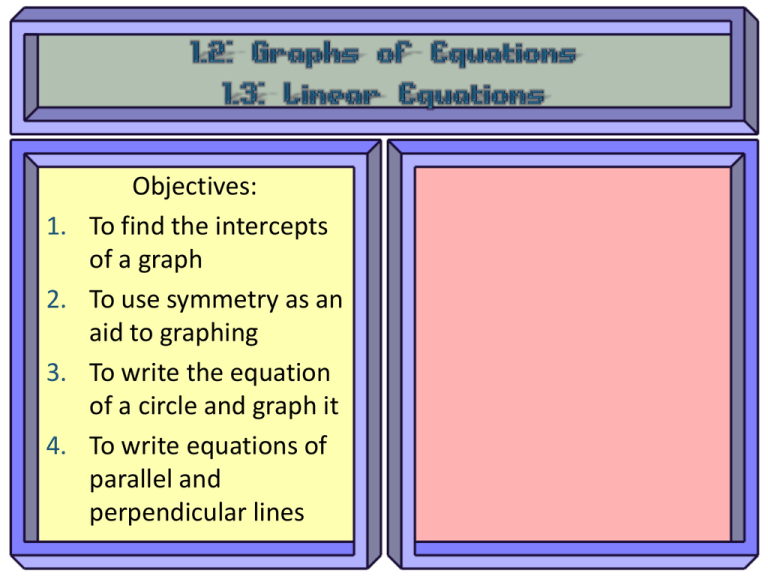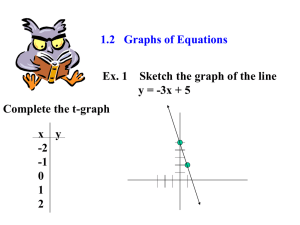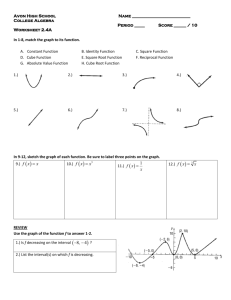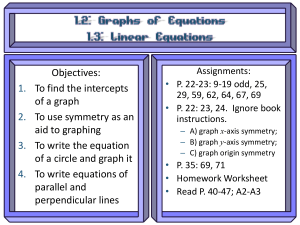1-2 Graphs of Equations 1.2_graphs_1.3_linear
advertisement

1. 2. 3. 4. Objectives: To find the intercepts of a graph To use symmetry as an aid to graphing To write the equation of a circle and graph it To write equations of parallel and perpendicular lines • As a class, use your vast mathematical knowledge to define each of these words without the aid of your textbook. Graph of an Equation Solution Point Intercepts Symmetry Circle Parallel Perpendicular The graph of an equation gives a visual representation of all solution points of the equation. The x-intercept of a graph is where it intersects the x-axis. • (a, 0) The y-intercept of a graph is where it intersects the y-axis. • (0, b) 6 4 y-intercept 2 -5 x-intercept 5 -2 How many x- and y-intercepts can the graph of an equation have? How about the graph of a function? Given an equation, how do you find the intercepts of its graph? • To find the x-intercepts, set y = 0 and solve for x. • To find the y-intercepts, set x = 0 and solve for y. Find the x- and y-intercepts of y = – x2 – 5x. A figure has symmetry if it can be mapped onto itself by reflection or rotation. Click me! How would an understanding of symmetry help you graph an equation? When it comes to graphs, there are three basic symmetries: 1. x-axis symmetry: If (x, y) is on the graph, then (x, -y) is also on the graph. x, y x, y When it comes to graphs, there are three basic symmetries: 2. y-axis symmetry: If (x, y) is on the graph, then (-x, y) is also on the graph. x, y x, y When it comes to graphs, there are three basic symmetries: 3. Origin symmetry: If (x, y) is on the graph, then (-x, -y) is also on the graph. x, y x, y (Rotation of 180) Using the partial graph pictured, complete the graph so that it has the following symmetries: 1. x-axis symmetry 2. y-axis symmetry 3. origin symmetry The set of all coplanar points is a circle if and only if they are equidistant from a given point in the plane. Find the equation of points (x, y) that are r units from (h, k). Standard form of the equation of a circle: x h y k 2 2 (h, k) = center point r = radius r 2 The point (1, -2) lies on the circle whose center is at (-3, -5). Write the standard form of the equation of the circle. Find the center and radius of the circle, and then sketch the graph. x 2 y 3 2 2 25 Convert the given equation to the following forms: 3 y 6 x 5 4 1. Slope-intercept form 2. Standard form Convert the given equation to the following forms: 3 x 7 y 10 1. Slope-intercept form 2. Point-slope form Two lines are parallel lines iff they are coplanar and never intersect. m || n Two lines are perpendicular lines iff they intersect to form a right angle. Two lines are parallel lines iff they have the same slope. Two lines are perpendicular lines iff their slopes are negative reciprocals. Write an equation of the line that passes through the point (-2, 1) and is: 1. Parallel to the line y = -3x + 1 2. Perpendicular to the line y = -3x + 1 1. 2. 3. 4. Objectives: To find the intercepts of a graph To use symmetry as an aid to graphing To write the equation of a circle and graph it To write equations of parallel and perpendicular lines





